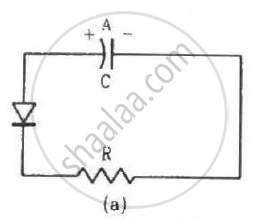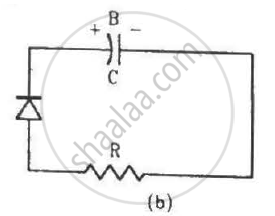Advertisements
Advertisements
प्रश्न
A semiconducting material has a band gap of 1 eV. Acceptor impurities are doped into it which create acceptor levels 1 meV above the valence band. Assume that the transition from one energy level to the other is almost forbidden if kT is less than 1/50 of the energy gap. Also if kT is more than twice the gap, the upper levels have maximum population. The temperature of the semiconductor is increased from 0 K. The concentration of the holes increases with temperature and after a certain temperature it becomes approximately constant. As the temperature is further increased, the hole concentration again starts increasing at a certain temperature. Find the order of the temperature range in which the hole concentration remains approximately constant.
(Use Planck constant h = 4.14 × 10-15 eV-s, Boltzmann constant k = 8·62 × 10-5 eV/K.)
उत्तर
Given:
Band gap = 1 eV
After doping,
Position of acceptor levels = 1 meV above the valence band
Net band gap after doping = (1 − 10−3) eV = 0.999 eV
According to the question,
Any transition from one energy level to the other is almost forbidden if kT is less than 1/50 of the energy gap.
\[\Rightarrow k T_1 = \frac{0 . 999}{50}\]
\[ \Rightarrow T_1 = \frac{0 . 999}{50 \times 8 . 62 \times {10}^{- 5}}\]
\[ \Rightarrow T_1 = 231 . 78 \approx 232 . 8 \] K
\[T_1\] is the temperature below which no transition is possible.
If kT is more than twice the gap, the upper levels have maximum population; that is, no more transitions are possible.
For the maximum limit,
\[\text{ K T}_2 = 2 \times {10}^{- 3} \]
\[ \Rightarrow T_2 = \frac{2 \times {10}^{- 3}}{8 . 62 \times {10}^{- 5}}\]
\[ \Rightarrow T_2 = \frac{2}{8 . 62} \times {10}^2 = 23 . 2 \] K
\[T_2\] is the temperature above which no transition is possible.
∴ Temperature range = 23.2−231.8
APPEARS IN
संबंधित प्रश्न
Distinguish between a metal and an insulator on the basis of energy band diagrams ?
We have valence electrons and conduction electrons in a semiconductor. Do we also have 'valence holes' and 'conduction holes'?
Electric conduction in a semiconductor takes place due to
An electric field is applied to a semiconductor. Let the number of charge carries be nand the average drift speed by v. If the temperature is increased,
Let np and ne be the number of holes and conduction electrons in an intrinsic semiconductor.
Two identical capacitors A and B are charged to the same potential V and are connected in two circuits at t = 0 as shown in figure. The charges on the capacitors at a time t = CRare, respectively,


An incomplete sentence about transistors is given below:
The emitter−..... junction is __ and the collector−..... junction is __. The appropriate words for the dotted empty positions are, respectively,
The electrical conductivity of pure germanium can be increased by
(a) increasing the temperature
(b) doping acceptor impurities
(c) doping donor impurities
(d) irradiating ultraviolet light on it.
A semiconductor is doped with a donor impurity.
When a semiconducting material is doped with an impurity, new acceptor levels are created. In a particular thermal collision, a valence electron receives an energy equal to 2kT and just reaches one of the acceptor levels. Assuming that the energy of the electron was at the top edge of the valence band and that the temperature T is equal to 300 K, find the energy of the acceptor levels above the valence band.
The conductivity of a pure semiconductor is roughly proportional to T3/2 e−ΔE/2kT where ΔE is the band gap. The band gap for germanium is 0.74 eV at 4 K and 0.67 eV at 300 K. By what factor does the conductivity of pure germanium increase as the temperature is raised from 4 K to 300 K?
With reference to Semiconductor Physics,
Draw a labelled energy band diagram for a semiconductor.
What is forbidden band?
The energy of a hydrogen atom in the ground state is −13.6 eV. The energy of a He+ ion in the first excited state will be:
A hole in a. p – type semiconductor is
An n-type semiconductor is
For germanium crystal, the forbidden gas energy gap
Which one of the following elements will require the highest energy to take out an electron from them?
Pb, Ge, C and Si
With reference to semiconductor physics, answer the following question.
What is meant by “Forbidden band" of energy levels?
